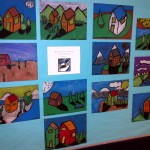02.15.13Nina Troiano’s ‘Mysterious Houses’
 Betcha didn’t think you’d see a post about the Art here. But actually, I love art and think it’s hugely important for students not only to “get” it in schools but to get high quality art instruction. (I think people assume our schools don’t believe in things like art but I’d actually argue they get MORE art in our schools than they might elsewhere.) Anyway, I’m a big fan of Troy Prep Middle School art teacher Nina Troiano’s work and am going to share an example that’s pretty inspiring.
Betcha didn’t think you’d see a post about the Art here. But actually, I love art and think it’s hugely important for students not only to “get” it in schools but to get high quality art instruction. (I think people assume our schools don’t believe in things like art but I’d actually argue they get MORE art in our schools than they might elsewhere.) Anyway, I’m a big fan of Troy Prep Middle School art teacher Nina Troiano’s work and am going to share an example that’s pretty inspiring.
In the pictures you’ll see examples of a project her fifth graders just completed: “Mysterious Houses.” The drawings, pastel on black construction paper, are inspired by a study of similar art work by Victoria Taylor-Gore. As you can see, the results are pretty stellar. I spent some time talking to Nina about her teaching and here are some highlights.
Nina started with what you might call art criticism. “It’s a pretty academic first day,” she said. “We started by reading about the artist in the Do Now- maybe two paragraphs with questions to answer. We discussed her approach and then we looked at one of her drawings.” It struck me that Nina’s class really “read” the drawing they looked at. They “interpreted it” and looked at is as artists. “We talked about why she did what she did and we were pulling out the elements we’ll use in our projects through guided discussion,” Nina said. “I was trying to allow the kids to give their own spin on what I think is a really eerie approach to landscape. So we talked about how the house was isolated, and that there were no people. But also that there were strange elements like a canoe in the foreground or a ladder up to a window that made you realize there might have been activity at one point. It made you realize there were no people but there should be. We talked about how the houses and trees were “stylized” and the houses were drawn in two point perspective but a distorted version of that.”
Next Nina’s kids practiced, a lot, they produced a final drawing. “The first day, we all draw together. We start with a house. We go step by step and break the house apart into shapes and angles and lines and what each line is doing. For example to make the house look like it’s receding, the front edge would be longer and then it fades back to shorter lines. So I draw it and we copy it together. After they’ve done that, it starts to make sense. Then I give them half complete houses in the packet that they have to complete. It becomes more independent. Then at the end they draw a house their own.” That’s interesting to me as a big believer in practice. “Towards the end they draw a full house and we start adding horizon lines and landscape details.” By the end of the first day Nina’s students have done multiple sketches and drawings of the houses that they’ll put in their final.
On day 2 they practiced the elements of landscape, especially the trees, in the same way. And in subsequent days they got more practice. “On day 2 for the Do Now we start with what we did previously. I had a half drawn house for them to complete. On day three I gave them a house and they had to add the landscape with stylized trees,” Nina said.
After a few days of practicing sketching the elements, students did a final draft. “I tell them it’s like a test. They have to show that they understand the points that we’ve hit. There are composition requirements: one house; at least four stylized trees, and a checklist on the side for important aspects: all of the tress with cast shadows, all of them pointing in the right direction, aligned with the sun; a mysterious element that suggests missing people. Then they could think about color. They did a crayons and colored pencil draft. They use that to guide their final copy. But before that we do demos wit oil pastels. How to get a vibrant color. How to blend.”
All pretty incredible stuff. At least I think. The part I like best is the inclusion of “academic study” (i.e. analysis of art and technique), technical vocabulary (stylized, two-point perspective), iterative technical practice (drawing the houses over and over) and specific goals (There’s a right way we are trying to draw the trees. Express yourself but also have the discipline to learn to craft like a master). Plus the results are beautiful.


Ms. Troiano sounds like a very inspiring teacher, one who takes both her own art and her students’ art seriously. I agree that art should be an integral part of our childrens’ education. It helps create harmony and balance for them. It is nice to see the arts recognized by Troy Prep, and just as nice to see our daughter recognized! ~Nina’s Mom